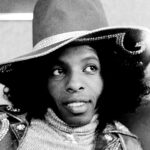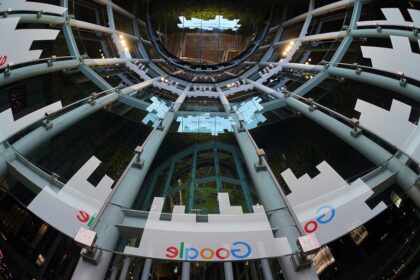When Disney princesses come to mind, we immediately think of their iconic dresses. However, the truth is that the fashion of the 18th century, which is depicted in movies, was quite different. To address this, we enlisted the help of an AI to create accurate versions of these characters' dresses. Now, we are excited to share the results with you.
1. Snow White in Germany's 15th century fashion

© Snow White and the Seven Dwarfs / Walt Disney Animation Studios
The story, first published in 1937, was based on Margaretha von Waldeck, a German countess born in 1533, indicating that the story takes place during that era.
In contrast to the dress depicted by Disney animators, women in the 15th century donned significantly more extravagant and high-waisted attire. These garments were adorned with multiple layers of linen underneath. Additionally, the sleeves of women's clothing were detachable and flared at the shoulders, which differed greatly from the Disney design.
2. Aurora in France's 14th century fashion
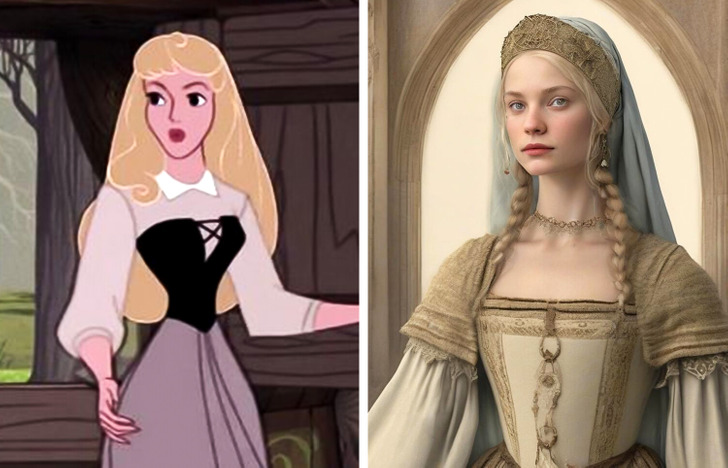
© Sleeping Beauty / Walt Disney Animation Studios
The story is most well-known from Charles Perrault's book, Histoires ou contes du temps passé, published in 1697. However, there are earlier records of the story dating back to the 14th century in the Perceforest. This suggests that the protagonist lived during that time.
During that era, women preferred wearing form-fitting dresses to avoid making their hips look wider. Dressmakers focused on minimizing volume in that area. Formal dresses often had long trains, and it was common to layer gowns over the dress, draping over the shoulders.
3. Cinderella in Germany's 19th century fashion

© Cinderella / Walt Disney Animation Studios
The story was first published by the Brothers Grimm in 1812 in their collection of Fairy Tales. However, the oldest records of this story date back to the 7th century B.C. and the 1st century A.D.
Thanks to the Brothers Grimm, Cinderella is forever known as a classic German fairy tale. Now, let's explore how Cinderella's appearance evolved in the 19th century. During this time, dresses became increasingly elaborate and dramatic, a fashion trend that persisted until the end of the Romanticism era.
4. Jasmin in Middle Eastern fashion
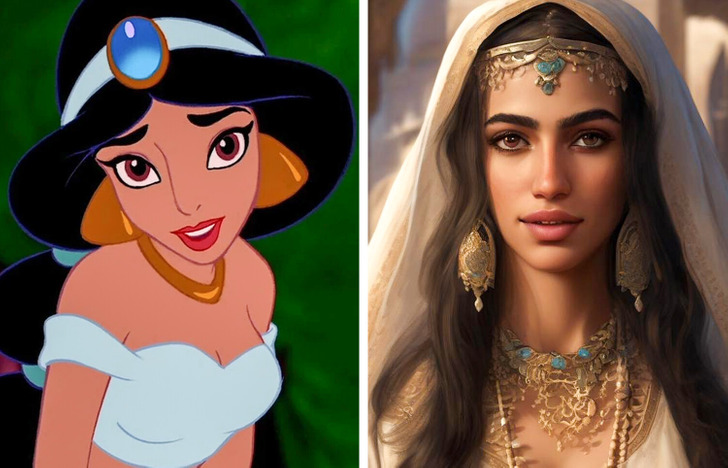
© Aladdin / Walt Disney Animation Studios and co-producers
Aladdin, a renowned tale from the Arabian Nights, is widely recognized. The story begins by mentioning “some of the cities of China” as the setting, but this location is not referred to again. Certain aspects hint that Aladdin's story unfolds in the ancient Middle East.
The story made it into the book because of Syrian writer Hanna Diyab. In ancient Arabic, “China” was used to describe faraway and exotic places. To stay true to the traditional story, we will imagine how Jasmine's attire would have been in the ancient Near East.
Clothing in this area has changed very little over time, as its main goal remains unchanged: to shield from the extreme weather conditions and sand. Consequently, the disparities between nations are rather minor.
The primary attire consisted of a shirt with sleeves, loose trousers, and a tunic. Later, the jellaba was introduced. It is a dress with long sleeves and a skirt featuring slits on the sides. These garments are predominantly in cream shades and adorned with vibrant fabrics.
5. Tiana in U.S.'s 1926 fashion
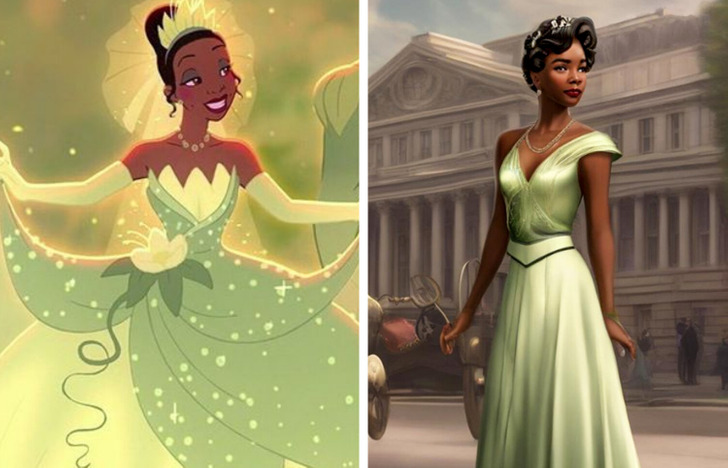
© The Princess and the Frog / Walt Disney Animation Studios and co-producers
The German original story was officially published by the Brothers Grimm in 1812, drawing inspiration from the country's rich oral tradition. However, Disney's 2009 adaptation takes a unique approach. It loosely derives from The Frog Princess, which is an adaptation of the original story published by E. D. Baker in 2002.
Given the clear deviations from the original story, let's delve into the fashion choices for Tiana in the 1920s, specifically in the United States as depicted in the Disney adaptation.
During that era, fashion was undergoing a transformation from the conventional styles. The focus was on embracing a more relaxed approach, resulting in loose-fitting and plunging dresses. These garments concealed the woman's silhouette and extended down to the ankles or occasionally to the knees.
6. Bella in France's 18th century fashion
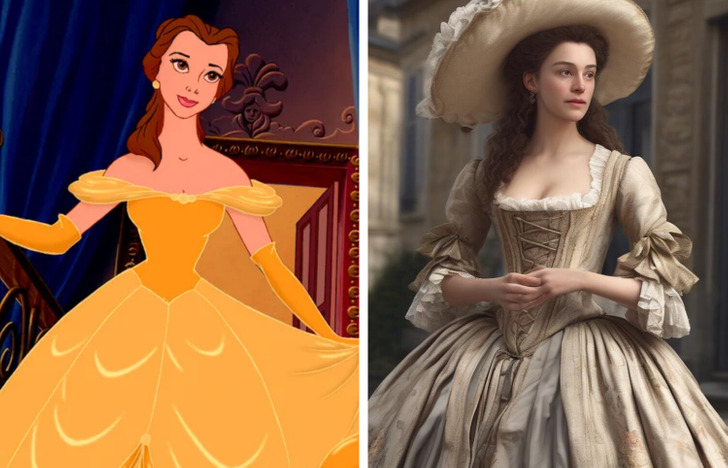
© Beauty and the Beast / Walt Disney Animation Studios and co-producers
Disney adapted the tale La Belle et la Bête, penned by French writer Gabrielle-Suzanne Barbot de Villeneuve in 1740, to create one of its beloved animated classics. It might seem like the story takes place during the same era it was written. If that were the case, Belle would have been dressed in a style reflecting 18th-century French fashion.
During that era, dresses commonly showcased a distinctive characteristic – a fitted bodice. These bodices were adorned with square necklines, adorned with large bows and ribbons, as well as delicate lace and flowers at the front. To create an elegant and youthful appearance, pastel colors were favored. The sleeves of these dresses were flared and gracefully ended at the elbows, allowing a glimpse of the nightgown sleeves worn underneath.
7. Merida in Scotland's 10th century fashion

© Brave / Walt Disney Animation Studios and co-producers
Brave, a Pixar film released in 2012, takes place in medieval Scotland and tells an original story. Unlike other Disney Princesses, Merida's costumes in the movie are incredibly realistic. They capture the essence of the time period. Nevertheless, certain aspects of medieval European fashion are not depicted in the film.
During that era, tunics were commonly worn as part of women's clothing. To add an extra layer, a long cloak could be worn as a coat, fastened to the inner garment with a waist belt. Furthermore, socks might have been worn on the legs and veils on the head.
8. Rapunzel in Germany's 17th century fashion

© Tangled / Walt Disney Animation Studios and co-producers
Tangled, which came out in 2010, is actually inspired by the tale of Rapunzel from the Brothers Grimm in 1812, which itself was based on the French story of Persinette by Charlotte-Rose de Caumont de La Force in 1698.
The tale of the missing princess takes place in Germany during the late 1600s. Back then, women donned corsets that were low-cut, with broad shoulders and a slim waist. The sleeves were loose and wide, stopping at the elbow, while the skirt gracefully flowed down to the feet. As time passed, though, the skirt's length was gradually reduced, revealing the lovely petticoat underneath.
9. Meg in Ancient Greece's fashion, 300 BC
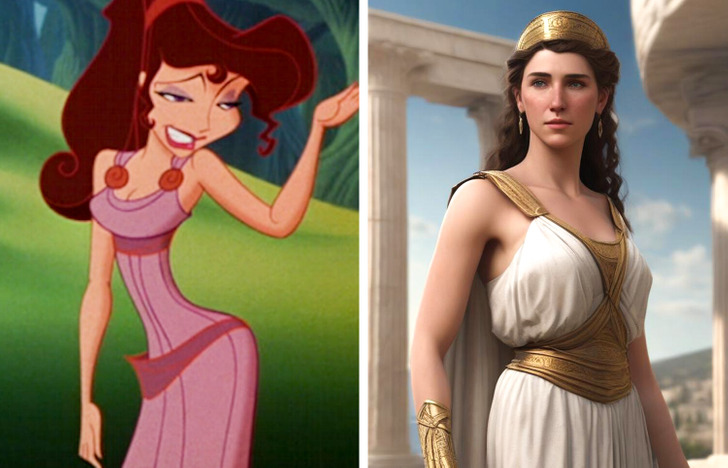
© Hercules / Walt Disney Animation Studios and co-producers
Hercules centers on the thrilling escapades of the Greek demigod. While the movie doesn't explicitly mention ancient Greece as the setting, one can deduce it from various references made throughout the film.
Greek women during that era opted for practical and modest attire, focusing on functionality rather than making a fashion statement. Their outfits typically comprised of two components: an undergarment and a cloak. Notably, women's tunics were longer, reaching down to the ankles, in contrast to men's tunics which stopped at the knees.
The colors used were frequently neutral, although tailors would incorporate vibrant hues for decorative borders. However, this practice was primarily prevalent among the upper classes. Among all the colors, purple was especially regarded as the most noticeable symbol of affluence in clothing due to its expensive nature.
10. Elsa in European 19th century fashion
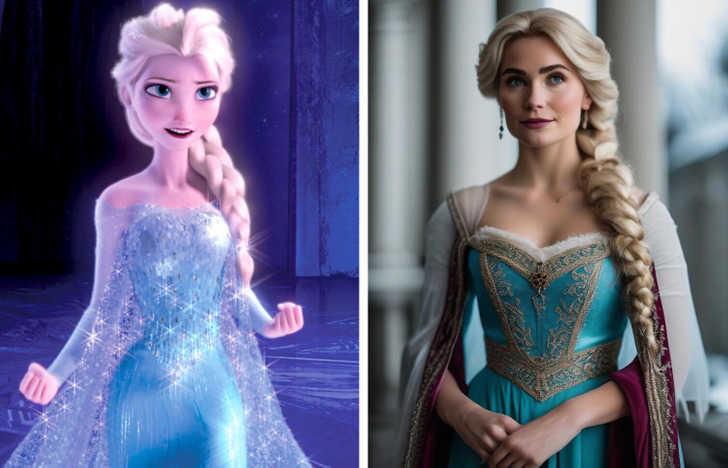
© Frozen / Walt Disney Animation Studios and co-producers
Frozen draws inspiration from the fairy tale The Snow Queen, written by the Danish author Hans Christian Andersen in 1844. While the kingdom of Arendelle is fictional, Disney's story is believed to be set in 19th century Europe, serving as a captivating backdrop for the enchanting tale.
If this analysis is accurate, Elsa probably had a fashion sense similar to Cinderella's, as European styles didn't differ much. Therefore, she likely wore a well-defined structure, a wide skirt, and extravagant decorations.
11. Ariel in 19th century fashion
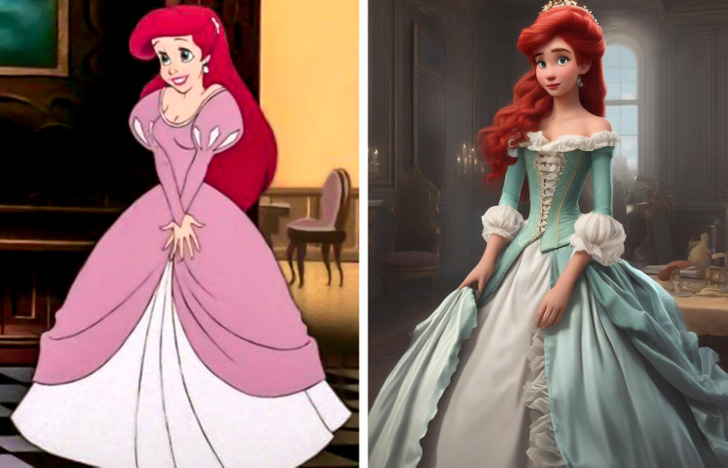
© The Little Mermaid / Walt Disney Pictures & co-producers
Ariel, the adventurous mermaid princess from Disney's classic animated film, makes a grand entrance in a historically accurate outfit inspired by the 1890s. Her stunning gown is crafted from luxurious emerald green satin, a nod to her iconic color. The bodice is embellished with delicate lace accents and showcases the fashionable leg-o-mutton sleeves of the time. Completing the look is a high-collared neckline that exudes sophistication and elegance. To accentuate her figure, Ariel wears a velvet sash around her waist, creating a flattering silhouette.
Version 1: As Ariel walks, the floor-length skirt gracefully cascades down, creating a beautiful and flowing movement. To complete her look, she sweeps up her fiery red hair in a timeless Gibson Girl hairstyle, highlighting her natural beauty and charm. While capturing the essence of the 1890s with this historically accurate costume, Ariel still manages to retain her own unique personality and charm.
Get ready to see a whole new side of your favorite Disney princesses! In our upcoming article, we'll be giving them villainous makeovers that will leave you stunned. Stay tuned for some wicked transformations!


